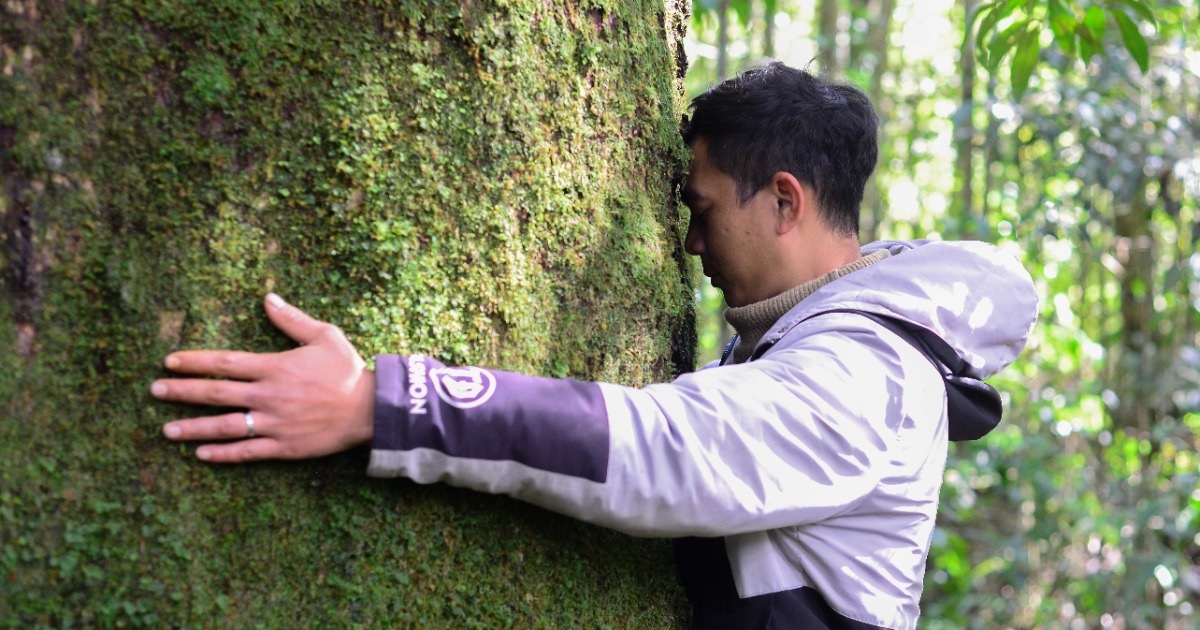At the beginning of the year, Mr. Du Na, a 35-year-old member of the K’Ho Cil ethnic group residing in Da Chais commune, Lac Duong district, Lam Dong province, joined forest rangers from Bidoup-Nui Ba National Park on a special patrol to protect the forest. This journey was not just a professional duty but also held deep spiritual significance for the K’Ho community.
The Intersection of Belief and Forest Conservation
When reaching the border area between Lam Dong and Khanh Hoa provinces, Mr. Du Na approached a large ancient tree with great reverence. He embraced the trunk of the tree, known as the “sacred tree,” pressed his head against its bark, and closed his eyes to pray. He believes that sincere prayers will be answered by the gods residing within the tree.
Mr. Du Na shared, “The elders in the village say that these thousand-year-old flat-leaved pines are homes to deities. Those with evil intentions or who desecrate this place will be punished. Conversely, those who respect and protect the trees will receive blessings.”
Special Biological and Cultural Value
Mr. Păng Tiang Min, a ranger at Hon Giao Forest Station under Bidoup-Nui Ba National Park, noted that the flat-leaved pine trees are distributed over a vast area with thousands of trees. Some trees are over 1,000 years old.
“All the ancient pines have been numbered for close monitoring and management. For the local people, these are not only rare trees but also revered symbols; no one dares to violate them,” emphasized Mr. Păng Tiang Min.
Flat-leaved pine (Pinus krempfii) is a unique species, now very rare worldwide. In Vietnam, it primarily appears in national parks like Chu Yang Sin (Dak Lak) and Phuoc Binh (Ninh Thuan), but is most concentrated in Bidoup-Nui Ba National Park. The two largest clusters are found in the ancient forest gate area (Dam Rong district) and the area managed by Hon Giao Forest Station.
Distinctive Ecological Conditions
The “sacred trees” thrive at altitudes above 2,000 meters above sea level, where dense fog frequently occurs. High humidity facilitates the growth of moss and orchids covering the tree trunks. Beneath the trees, a thick layer of humus about 1 meter deep retains moisture and provides nutrients for the trees.
Mr. Nguyễn Lương Minh, Deputy Director of Bidoup-Nui Ba National Park, affirmed that through modern scientific methods, many flat-leaved pines here have been identified as being 700 to 1,100 years old. This is a living testament to the harmonious blend of cultural beliefs and conservation efforts.
Sustainable Tourism Development
Currently, Bidoup-Nui Ba National Park is organizing eco-tourism routes to bring visitors to explore the two clusters of “sacred trees.” These activities not only promote the unique cultural values of the K’Ho people but also raise community awareness about the importance of protecting forests.
Conclusion
The thousand-year-old “sacred trees” are not only valuable natural heritage but also spiritual symbols of the K’Ho Cil people. Protecting and promoting the value of these tree clusters is crucial for preserving cultural identity and building a sustainable future for future generations.
Learn more about conservation efforts and eco-tourism programs at Bidoup-Nui Ba National Park to help spread the message of environmental protection!
References
- Dan Tri Online: Original article link



